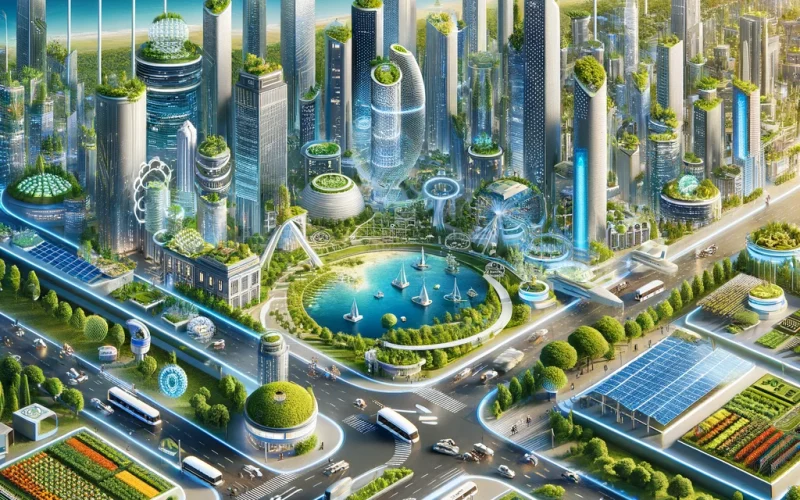

Urban areas are increasingly recognized as pivotal arenas for the global net zero transition, critical to mitigating climate change and fostering sustainable development. The ambition to limit global warming necessitates a transformative approach in city planning and management, embracing models that not only target emissions reduction but also enhance resilience, liveability, and technological advancement.
In this article we also give you a few examples of cities that already implement this philosophy.
What is Net Zero ?
Net zero refers to achieving a balance between the greenhouse gases emitted into the atmosphere and the greenhouse gases removed from it. This state is reached when the amount of carbon dioxide or other greenhouse gases released by human activities is equal to the amount that is naturally absorbed by the earth (through forests, oceans, or other means) or artificially removed through carbon capture and storage technologies.
The goal of reaching net zero emissions is crucial for mitigating climate change and limiting global warming, as outlined in international agreements like the Paris Agreement. Achieving net zero involves a significant reduction in emissions across all sectors of the economy, including energy production, transportation, agriculture, and industry, complemented by efforts to enhance natural carbon sinks and develop technologies that can remove carbon from the atmosphere.
The Rise of the 15-Minute City: A Model for Sustainable Urban Living
The “15-Minute City” concept emerges as a compelling model for net zero urban futures, advocating for a city layout where residents can access work, education, and leisure facilities within a 15-minute walk or bike ride from their homes. This model prioritizes complexity, human interaction, and liveability, presenting a pathway toward sustainable urban regeneration. However, achieving this requires overcoming significant financial hurdles, especially in the post-pandemic context where economic disruptions have shifted priorities. Successful implementation hinges on strategic partnerships between the public and private sectors, leveraging special economic zones and urban regeneration schemes to catalyze investment and community engagement.
Sustainable Cities
Sustainable cities strive for a balance that integrates environmental care with economic, social, and ecological well-being, ensuring long-term viability and anticipation of environmental risks.
- San Pedro Garza Garcia, Mexico, is committed to reducing 15,000 tons of CO2 by 2024 through initiatives such as arborization, energy efficiency in municipal buildings, and the use of sustainable fuels.
- Melbourne, Australia, has launched the Urban Forest Fund to support greening projects that contribute to biodiversity, water evaporation benefits, and reduction of landfill waste through the use of recycled materials.
- Toronto, Canada, has set ambitious targets under its TransformTO Net Zero Strategy, including making all new homes and buildings near-zero greenhouse gas emitters by 2030.
Resilient Cities
Resilient cities are prepared to withstand and recover from a variety of shocks and stresses, including economic, environmental, social, or institutional challenges.
- Peñalolén, Chile, enhances its environmental policy through collaboration with other municipalities, social organizations, and educational institutions, promoting sustainable practices and climate action.
- Quelimane, Mozambique, focuses on urban agriculture to improve food security and resilience against climate impacts, with projects like “Quelimane Agricola” to enhance agricultural practices.
- The State of Yucatán, Mexico, is actively working on sustainable mobility, deforestation reduction, and circular economy practices to bolster its climate resilience.
Smart Cities
Smart cities utilize digital and telecommunication technologies to enhance urban functionality, improve service delivery, and foster a high quality of life.
- New York City, USA, has introduced the Clean Construction Act, aiming for carbon neutrality by 2050 through sustainable materials and practices in construction projects.
- Ahmedabad, India, demonstrates the potential of municipal bonds as a financing mechanism for green projects, supporting climate-resilient urban development.
- Chengdu, China, envisions becoming a park city by 2050, with extensive networks of paths for pedestrians and cyclists, and smart systems across various sectors.
Toward a Sustainable and Resilient Urban Future
The journey to net zero cities encompasses a comprehensive approach that melds sustainable city planning, resilience building, and the adoption of smart technologies. The collective effort of policymakers, businesses, and civil society is crucial in transforming urban landscapes into beacons of sustainability and resilience. This ensures cities not only play a pivotal role in climate change mitigation but also provide a high quality of life for their inhabitants, highlighting the diverse yet converging paths toward achieving net zero emissions.
